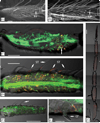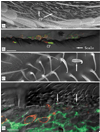Identification and characterization of an odorant receptor from the West Nile virus mosquito, Culex quinquefasciatus
- PMID: 16503478
- PMCID: PMC3100213
- DOI: 10.1016/j.ibmb.2005.12.003
Identification and characterization of an odorant receptor from the West Nile virus mosquito, Culex quinquefasciatus
Abstract
Members of the Culex pipens mosquito group including C. quinquefasciatus are responsible for the transmission of Bancroftian filarisis as well as West Nile Virus (WNV) in the United States. As is the case for other mosquitoes, the host preference of this disease vector relies on olfaction and accordingly mediated via G-protein coupled signal transduction pathways. Here, we identify and characterize CqOR7, the first candidate member of the odorant receptor gene family from C. quinquefasciatus. CqOR7 displays extremely high primary amino acid conservation with other apparent orthologs including AaOR7, from the Dengue virus vector mosquito Aedes aegypti, AgOR7 from the malaria vector Anopheles gambiae and DOr83b from the fruit fly Drosophila melanogaster that form an essential non-conventional odorant receptor sub-family. CqOR7 transcripts can be detected in adult chemosensory tissues and during several pre-adult stages of C. quinquefasciatus, and the CqOR7 protein is localized to characteristic olfactory tissues such as the antennae and maxillary palps as well as the proboscis, a typically gustatory appendage. These results suggest that CqOR7 and its orthologs are likely to play a role in the chemosensory processes of Culicine and other mosquitoes that underlie their vectorial capacity.
Figures




Similar articles
-
Identification of a chemosensory receptor from the yellow fever mosquito, Aedes aegypti, that is highly conserved and expressed in olfactory and gustatory organs.Chem Senses. 2004 Jun;29(5):403-10. doi: 10.1093/chemse/bjh041. Chem Senses. 2004. PMID: 15201207
-
Identification of microRNAs expressed in two mosquito vectors, Aedes albopictus and Culex quinquefasciatus.BMC Genomics. 2010 Feb 18;11:119. doi: 10.1186/1471-2164-11-119. BMC Genomics. 2010. PMID: 20167119 Free PMC article.
-
Sequencing of Culex quinquefasciatus establishes a platform for mosquito comparative genomics.Science. 2010 Oct 1;330(6000):86-8. doi: 10.1126/science.1191864. Science. 2010. PMID: 20929810 Free PMC article.
-
Genome analysis and expression patterns of odorant-binding proteins from the Southern House mosquito Culex pipiens quinquefasciatus.PLoS One. 2009 Jul 16;4(7):e6237. doi: 10.1371/journal.pone.0006237. PLoS One. 2009. PMID: 19606229 Free PMC article.
-
The contribution of Culex pipiens complex mosquitoes to transmission and persistence of West Nile virus in North America.J Am Mosq Control Assoc. 2012 Dec;28(4 Suppl):137-51. doi: 10.2987/8756-971X-28.4s.137. J Am Mosq Control Assoc. 2012. PMID: 23401954 Review.
Cited by
-
Molecular characterization and immunolocalization of the olfactory co-receptor Orco from two blood-feeding muscid flies, the stable fly (Stomoxys calcitrans, L.) and the horn fly (Haematobia irritans irritans, L.).Insect Mol Biol. 2013 Apr;22(2):131-42. doi: 10.1111/imb.12009. Epub 2013 Jan 1. Insect Mol Biol. 2013. PMID: 23278866 Free PMC article.
-
Expressional and functional interactions of two Apis cerana cerana olfactory receptors.PeerJ. 2018 Jun 11;6:e5005. doi: 10.7717/peerj.5005. eCollection 2018. PeerJ. 2018. PMID: 29910990 Free PMC article.
-
Identification and Knockdown of the Olfactory Receptor (OrCo) in Gypsy Moth, Lymantria dispar.Int J Biol Sci. 2015 May 22;11(7):772-80. doi: 10.7150/ijbs.11898. eCollection 2015. Int J Biol Sci. 2015. PMID: 26078719 Free PMC article.
-
An odorant receptor from the southern house mosquito Culex pipiens quinquefasciatus sensitive to oviposition attractants.PLoS One. 2010 Apr 8;5(4):e10090. doi: 10.1371/journal.pone.0010090. PLoS One. 2010. PMID: 20386699 Free PMC article.
-
Insect-Microorganism Interaction Has Implicates on Insect Olfactory Systems.Insects. 2022 Nov 28;13(12):1094. doi: 10.3390/insects13121094. Insects. 2022. PMID: 36555004 Free PMC article. Review.
References
-
- Bowen Q. Sensory aspects of host location in mosquitoes. In: Bock GR, Cardew G, editors. Olfaction in Mosquito-host Interactions. New York: Wiley; 1996. pp. 197–211.
-
- Clyne PJ, Certel SJ, et al. The odor specificities of a subset of olfactory receptor neurons are governed by Acj6, a POU-domain transcription factor. Neuron. 1999a;22(2):339–347. - PubMed
-
- Clyne PJ, Warr CG, et al. A novel family of divergent seven-transmembrane proteins: candidate odorant receptors in Drosophila. Neuron. 1999b;22(2):327–338. - PubMed
-
- Gao Q, Chess A. Identification of candidate Drosophila olfactory receptors from genomic DNA sequence. Genomics. 1999;60:31–39. - PubMed
Publication types
MeSH terms
Substances
Grants and funding
LinkOut - more resources
Full Text Sources
Research Materials

